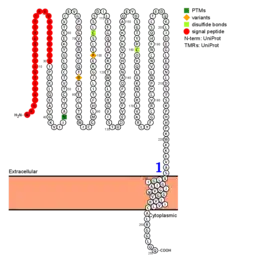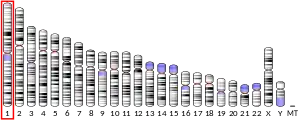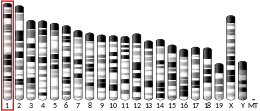TMEM81
Transmembrane Protein 81 or TMEM81 is a protein that in humans is encoded by the TMEM81 gene. TMEM81 is a poorly-characterized transmembrane protein which contains an extracellular immunoglobulin domain.[6]
| TMEM81 | |||||||||||||||||||||||||||||||||||||||||||||||||||
|---|---|---|---|---|---|---|---|---|---|---|---|---|---|---|---|---|---|---|---|---|---|---|---|---|---|---|---|---|---|---|---|---|---|---|---|---|---|---|---|---|---|---|---|---|---|---|---|---|---|---|---|
| Identifiers | |||||||||||||||||||||||||||||||||||||||||||||||||||
| Aliases | TMEM81, HC3107, KVLA2788, UNQ2788, transmembrane protein 81 | ||||||||||||||||||||||||||||||||||||||||||||||||||
| External IDs | MGI: 1921876 HomoloGene: 12579 GeneCards: TMEM81 | ||||||||||||||||||||||||||||||||||||||||||||||||||
| |||||||||||||||||||||||||||||||||||||||||||||||||||
| |||||||||||||||||||||||||||||||||||||||||||||||||||
| |||||||||||||||||||||||||||||||||||||||||||||||||||
| |||||||||||||||||||||||||||||||||||||||||||||||||||
| Wikidata | |||||||||||||||||||||||||||||||||||||||||||||||||||
| |||||||||||||||||||||||||||||||||||||||||||||||||||
Gene
TMEM81 is also known as HC3107, UNQ2788, KVLA2788,[6] or MGC75217.[7] In humans, TMEM81 is located on chromosomal band 1q32.1 between the genes CNTN2 and RBBP5 on the reverse strand.[8] The TMEM81 gene is 1332 base pairs long and encodes one transcript containing a single exon.[6][9]
The predicted promoter region (GXP_180875) for TMEM81 is 1158 bp long and extends from 205,084,360 to 205,085,517 on the reverse strand.[10]
Protein

The TMEM81 precursor peptide is 255 amino acids long with a predicted molecular weight of 28.5 kDa and pI = 8.92.[11]
The protein contains a helical transmembrane region, an extracellular immunoglobulin domain, and an N-linked glycosylation site. A disulfide bridge is predicted to form between residues Cys104 and Cys156.[11]
Protein composition

The mature form (signal peptide removed) of TMEM81 has a slightly increased valine and somewhat decreased methionine composition relative to average proteins.[13] TMEM81 also contains three charge runs, each of which are three amino acids long:
| Charge | Amino acids | Location |
|---|---|---|
| + | Arg-Arg-Lys | 71–73 |
| - | Asp-Asp-Glu | 131–133 |
| + | Lys-Lys-Lys | 221–223 |
Secondary structure
The extracellular region of TMEM81 is predicted to be composed of beta sheets while the intracellular region likely assumes an alpha helix conformation. The transmembrane region of TMEM81 is helical.[14] An alignment of mature TMEM81 peptide sequences in H. sapiens, M. musculus and G. gallus was used to predict the secondary structure of TMEM81 using Ali2D.[15]
.png.webp)
In predication results given above, blue indicates beta strands while red indicates alpha helices. Color saturation is proportional to the confidence of the predication.
Tertiary structure
.png.webp)
The tertiary structure of TMEM81 has been predicted using izumo sperm-egg fusion protein 1 as a template. The image on the right depicts a model of residues 19 to 152 with 97.3% confidence with 56% coverage obtained using Phyre2.[16] The red-to-blue color gradation indicates the N- to C-terminus directionality of the structure.
Post-translational modifications
Experimental evidence has been found for an N-glycosylation site located at Asn45 indicating that TMEM81 is a glycoprotein.[14] Several tyrosine residues within TMEM81 have been predicted to undergo sulfation.[17]
Subcellular location
TMEM81 is predicted to be localized to the plasma membrane.[6] However, immunohistochemistry experiments using TMEM81-specific antibodies found localization to intermediate filaments[18] and microfilaments.[19]
Expression
Expression in humans
RNA-seq experiments from the GTEx project found that TMEM81 is ubiquitously expressed in humans but shows enhanced expression in the cerebellum and cerebellar hemisphere.[20] Other tissues and organs showing somewhat enhanced mRNA expression include the testis and spleen.
Expression in rodents
In mice (M. musculus) and rats (R. norvegicus), TMEM81 shows enhanced expression in the testes and relatively low expression in other tissues.[21][22] Additionally, TMEM81 expression is not localized to the cerebellum in mice.[23]
TMEM81 shows monoallelic expression in both H. sapiens and M. musculus.[24]
Clinical Significance
Methylation changes in TMEM81 are associated with an increased risk of intermittent explosive disorder.[27] Additionally, SNPs located in TMEM81 affect thrombopoiesis, mean platelet volume,[28] and have been implicated in Meniere’s disease.[29]
Cancer
The 1q32.1 region showed copy number gain with a frequency of 68.9% in a study of 46 breast cancers[30] and was gained in a case of extraventricular central neurocytoma.[31] TMEM81 also has been implicated in the development of hepatocellular carcinoma.[32]
Homology
No paralogs of the TMEM81 gene exist in humans. Orthologs of the gene have been found in various lineages of gnathostomes with the most distantly orthologs found among chondrichthyes. TMEM81 orthologs have not been detected among agnatha, lancelets, tunicates, or invertebrates.
| Taxonomic name | Common name | Date of divergence (mya)[33] | NCBI Accession # | Length (aa) | Identity (%) [34] |
|---|---|---|---|---|---|
| Homo sapiens | Human | 0 | NP_976310 | 255 | 100 |
| Mus musculus | Mouse | 89 | NP_083301.1 | 259 | 69.8 |
| Tursiops truncatus | Dolphin | 94 | XP_019773842.1 | 251 | 81.4 |
| Loxodonta africana | Elephant | 102 | XP_023404078.1 | 276 | 70.6 |
| Ornithorhynchus anatinus | Platypus | 180 | XP_001507541.1 | 281 | 54.4 |
| Aptenodytes forsteri | Penguin | 318 | XP_009271191.1 | 264 | 45.7 |
| Notechis scutatus | Snake | 318 | XP_026532625.1 | 241 | 41.9 |
| Melopsittacus undulatus | Budgerigar | 318 | XP_005140927.2 | 297 | 36.9 |
| Microcaecilia unicolor | Caecilian | 352 | XP_030077474.1 | 266 | 38.1 |
| Latimeria chalumnae | Coelacanth | 414 | XP_005989300.1 | 254 | 34.4 |
| Amphiprion ocellaris | Clownfish | 433 | XP_023128675.1 | 256 | 24.9 |
| Rhincodon typus | Whale shark | 465 | XP_020374416.1 | 257 | 29.2 |
References
- GRCh38: Ensembl release 89: ENSG00000174529 - Ensembl, May 2017
- GRCm38: Ensembl release 89: ENSMUSG00000048174 - Ensembl, May 2017
- "Human PubMed Reference:". National Center for Biotechnology Information, U.S. National Library of Medicine.
- "Mouse PubMed Reference:". National Center for Biotechnology Information, U.S. National Library of Medicine.
- "I-TASSER (Iterative Threading ASSEmbly Refinement". Zhang Lab.
- "TMEM81". GeneCards. Weizmann Institute of Science.
- "Symbol report for TMEM81". GeneNames. HUGO Gene Nomenclature Committee (HGNC).
- "TMEM81". BioCyc. SRI International.
- "Gene: TMEM81". Ensembl Genome Browser. European Bioinformatics Institute (EMBL-EBI).
- "Genomes and Annotation: ElDorado". Genomatix Software Suite. Genomatix GmbH.
- "TMEM81 - Proteomics". neXtProt. Swiss Institute of Bioinformatics.
- "Protter". ETH Zurich Wollscheid Lab.
- "Statistical Analysis of Protein Structure". European Bioinformatics Institute (EMBL-EBI).
- "Homo sapiens transmembrane protein 81 (TMEM81), mRNA". NCBI Nucleotide Database. National Center for Biotechnology Information. 12 December 2020.
- "Ali2D". MPI Bioinformatics Toolkit. Max Planck Institute for Developmental Biology.
- "Phyre2". Protein Homology/analogY Recognition Engine V 2.0. Imperial College London.
- "Sulfinator". Expasy. Swiss Institute of Bioinformatics.
- "TMEM81 Subcellular". The Human Protein Atlas. SciLifeLab, Uppsala University, KTH Royal Institute of Technology.
- "Anti-TMEM81 antibody produced in rabbit". MilliporeSigma. Merck Group.
- "Gene Page TMEM81". GTEx Portal. Broad Institute of MIT and Harvard.
- "Tmem81 transmembrane protein 81 [ Mus musculus (house mouse) ]". NCBI Gene Database. National Center for Biotechnology Information (NCBI).
- "Tmem81 transmembrane protein 81 [ Rattus norvegicus (Norway rat) ]". NCBI Gene Database. National Center for Biotechnology Information (NCBI).
- "TMEM81 Brain". The Human Protein Atlas. SciLifeLab, Uppsala University, KTH Royal Institute of Technology.
- "dbMAE". dbMAE: the database of autosomal monoallelic expression. Gimelbrant Lab.
- "TMEM81 Homo sapiens protein". PAXdb: Protein Abundance Database. Swiss Institute of Bioinformatics, University of Zurich.
- "Tmem81 Mus musculus protein". PAXdb: Protein Abundance Database. Swiss Institute of Bioinformatics, University of Zurich.
- Montalvo-Ortiz JL, Zhang H, Chen C, Liu C, Coccaro EF (January 2018). "Genome-Wide DNA Methylation Changes Associated with Intermittent Explosive Disorder: A Gene-Based Functional Enrichment Analysis". The International Journal of Neuropsychopharmacology. 21 (1): 12–20. doi:10.1093/ijnp/pyx087. PMC 5789263. PMID 29106553.
- Shameer K, Denny JC, Ding K, Jouni H, Crosslin DR, de Andrade M, et al. (January 2014). "A genome- and phenome-wide association study to identify genetic variants influencing platelet count and volume and their pleiotropic effects". Human Genetics. 133 (1): 95–109. doi:10.1007/s00439-013-1355-7. PMC 3880605. PMID 24026423.
- Campbell CA (2010). \Identification of a genetic contribution to Meniere's disease (Ph.D. thesis). University of Iowa, USA).
- Kawauchi S, Furuya T, Ikemoto K, Nakao M, Yamamoto S, Oka M, Sasaki K (October 2010). "DNA copy number aberrations associated with aneuploidy and chromosomal instability in breast cancers". Oncology Reports. 24 (4): 875–83. doi:10.3892/or.2010.875. PMID 20811667.
- Myung JK, Cho HJ, Park CK, Chung CK, Choi SH, Kim SK, Park SH (April 2013). "Clinicopathological and genetic characteristics of extraventricular neurocytomas". Neuropathology. 33 (2): 111–121. doi:10.1111/j.1440-1789.2012.01330.x. PMID 22672632. S2CID 2024518.
- Chen J, Qian Z, Li F, Li J, Lu Y (January 2017). "Integrative Analysis of Microarray Data to Reveal Regulation Patterns in the Pathogenesis of Hepatocellular Carcinoma". Gut and Liver. 11 (1): 112–120. doi:10.5009/gnl16063. PMC 5221868. PMID 27458175.
- "TimeTree". Temple University.
- "Standard Protein BLAST". BLAST. National Center for Biotechnology Information.




_from_I-TASSER.png.webp)